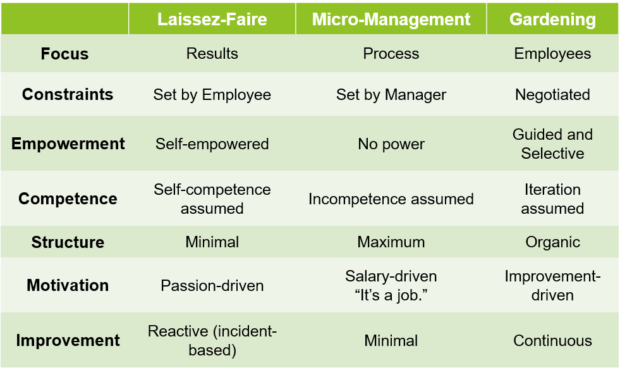
“What is your management philosophy?” was the question asked, pretty innocently. I’d been a manager for over a year at this point, and oddly enough, this was the very first time someone was asking me this question. Fortunately for the asker, as well as my team members, I had a management philosophy already crafted. It had been built up over the years after seeing many of the extremes in the high-autonomy startup world as well as the high-bureaucracy government. It fact, they all already had metaphors.
Lazy-Boy Leadership

We can all imagine the scene as it is become cliche through the years. The kids, alone in the kitchen, playing some game that is trying to run the fine line between not being too obnoxiously loud and not being so quiet that it creates suspicion and warrants parental intervention. The caretaker is alone in the living room resting comfortably on a giant, worn la-z-boy recliner. Drink in hand, watching the game, and generally ignoring the children’s hijinks in the other room.
There tend to be only a few occasions when the parent in this situation would interact with the kids. The first is in an emergency when one of the children has hurt themselves during play. The second is typically a loud, sharp rebuke to keep it down because their raucous play is disrupting the enjoyment of the game – the dreaded “Don’t make me come in there!” And lastly, the third is that growing quiet where you know the children are doing something, and they don’t want to get caught. In general though, the entire afternoon could go by without a single interaction – both good and bad – between the kids and their guardian.
As you can imagine, this metaphor calls out the general approach of laissez-faire leadership.
“Laissez-faire leadership, also known as delegative leadership, is a type of leadership style in which leaders are hands-off and allow group members to make the decisions. Researchers have found that this is generally the leadership style that leads to the lowest productivity among group members.” — Kendra Cherry, Very Well Mind
This leadership style denotes a high level of trust and typically works well in highly-creative or ambiguous situations. The leader often knows the least about what is going on in the day-to-day, and is the least informed to provide creative suggestions or direction. This can be amazing for certain types of employees that need the freedom to create or design unencumbered by process or bureaucracy. Guidance, direction, and oversight tend to be lacking, although leaders will often still provide appropriate tooling and resources. Ultimately, if an incident were to occur, the leader will still be there to escalate and assist.
As you can imagine though, there are definite cons to this strategy. There are very few clear boundaries set until you get the sharp, commonly anger-driven correction. There is also a lack of awareness and engagement, including praise or more guided learning that could be more beneficial, like the difference between training alone or with a personal trainer. A major recommendation to improve this strategy is to over communicate a lot more clearly. First, it is good to make sure northstars and guiding principals are clear and overly obvious. (i.e. Don’t play with the knives). Second, it’s good to provide ways to get problems surfaced in more periodic and perhaps socially safer ways. Ultimately, these steps would help reduce the harsh rebukes that likely can come from someone overstepping an unexpressed boundary or from bringing to light a small problem before it becomes a big problem.
Myopic Micromanagement

As you can imagine, the opposite extreme is the helicopter parent that must control everything about their child’s lives. The guardian that lacks trust in the input and output of their charges, and must attend to every little thing. The calendar must be filled with supervised play dates, the play is completely guided and possibly stifling. There is little room for freedom or creativity, but all time is spent productively and with high levels or quality control. This is the parent with an app on their kid’s phone that is paying attention to everything at the detriment of the parent’s own time (and possibly sanity).
This leadership style denotes a very low level of trust and can work very well in highly-structured environments. The leader often knows the most about what is going on in the day-to-day life of their team. They know what needs to be done as the process has been stable for years (if not decades), and it simply needs enforced. This management style can actually be pretty amazing for employees that need more structure and guidance, and for roles that need consistent output. The downside is of course how both stifling and boring it can be at times. Guidance, direction, and oversight are at their zenith, and if an incident were to occur, the leader will still be right there to escalate and assist. The primary issue here is the engagement of the manager likely reduces the engagement and ultimate authority of the employee – not to mention the final credit.
“I am sending emails with Read Receipts and many of you are not accepting the Read Receipt to confirm that you have read my messages and I am having to waste a lot of time calling you to confirm it was read.” — An actual email I received from an actual manager
A major recommendation here is to micromanage a bit less by defining goals and not methods. For example, the goal is to provide a happy customer, the method should leave some room open to improvisation and creativity. This would still allow the employee to feel more engaged without necessarily removing the oversight and consistency of results that may be required for such a position. For example, defining that the child must do an after-school activity, but not necessarily dictating which one.
The Mindful Gardener

And at last, we arrive at the Goldilocks solution that I feel incorporates the best of both worlds. Consider the attentive gardener: the majority of the time the plants are left to their own devices through a benign neglect. They are relatively ignored aside from a few moments of intense care and interaction. Imagine those weekend hours when obstacles such as weeds and pests are removed. Resources are provided as necessary: Maybe the plant needs more water, maybe they need moved to more light or less light. The goal is to make sure one recognizes what the plant is trying to do, and make sure its empowered to be the best version of itself.
“By becoming a gardener instead of just a gatekeeper, you solve for the team, solve for yourself, and help scale the organization as a whole.” — Jared Williams, ThinkGrowth.org
This leadership style denotes a very high level of trust and is primarily suited to a highly creative environment. The leader knows the most about their resources and of what they are capable. What they may not know is the final process that needs to be performed. I’d argue this management style strikes a healthy balance between providing some light structure or guidance (think scaffolding for the tomatoes), and providing the freedom for creativity and ownership. So, this method provides flexibility for both those employees that may need more initial structure and those that will grow like weeds if only left to their own ambition.
So, there are some initial gains compared to the other strategies. Unlike the micromanager, there is not an expectation that every employee is a machine with precise a cookie-cutter output. And unlike the laissez-faire leader, there is more dedicated paths to support and enablement. However, there is a crucial assumption that the employee knows themselves, their preferences and their goals. If the employee thinks they are a tomato plant, but are more fulfilled acting like a potato plant, there will be some growing pains with this strategy. Assuming employees know what they want and need is a crucial assumption of the gardener strategy.
The downside of this strategy is the attentiveness it requires of on the manager, and the assumption it makes . It requires a high level of empathy, awareness and humility. You need to know your employees well enough to understand their strengths, weaknesses, and ambitions. There needs to be a high level awareness to make sure your team is growing and experiencing realistic challenge and occasional failure. And ultimately, humility to recognize that none of the results are really your own. When an employee knocks it out of the park, that credit is theirs, just as those delicious vegetables. A gardener can work diligently in their garden. They can water, prune and weed, but at the end of growing season, all they really did was let the corn, tomatoes, or kale come out the best that nature would allow.
Conclusion

You could easily take each of the styles and consider them with a garden metaphor. The hands-off manager is creating an environment of creativity and chaos. They are creating the wild jungle that will let evolution take its course against the weeds and the predators. This will let driven, eager and adaptable plants succeed beyond imagination, but may come with unforeseen consequences. The micro-manager is creating the highly controlled hydroponic environment with the structured boredom of scheduled watering and constant attention that guarantees consistently acceptable results. And lastly, my philosophy is the backyard garden that provides both freedom and care to enable the plants to produce the best they can.



Good article. I’ve run into all of these styles of management in my working life. I really like to think of myself as a gardener, but can see how one could slip into a Lazy Boy or suddenly make everyone install Togl. It’s a bit more of a continuum, I think.